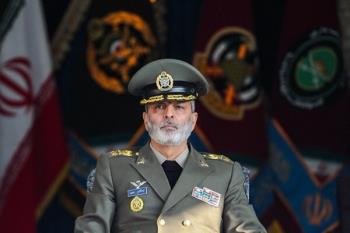Alwaght- After over a decade of leadership over the Ansarullah Movement of Yemen, Sayed Abdul-Malik Badreddin al-Houthi has transferred into the powerful, influential, and top man of Yemen. Such a promotion in the political position was not outcome of personal wealth or media propaganda. Rather, it has roots in his intellectual characteristics and experiences on the stage of the politics and organizational makeup of the Ansarullah.
Al-Houthi’s biography
Sayed Abdul-Malik Badreddin al-Houthi was born in1979 to Sayed Badreddin al-Houthi, the spiritual leader of the Ansarullah. The record of the politico-religious activities of the al-Houthi family dates back to the activities of Sheikh Badreddin Mohammad al-Houthi and his father who were the religious scholars in Yemen.
The victory of the Islamic Revolution in Iran that brought down a strong Western-backed monarchy gave a special influence to the al-Houthis’ discourse in Yemen, to an extent that Sheikh Badreddin called for changes to the political and religious manifesto of Zaidiyyah, the dominant faith in Yemen. This caused differences between him and other Zaidiyyah scholars. He then founded the Youth Alliance in Yemen in1986.
A couple of years later, he founded the School of Believer Youths, in 1992. Although both of the bodies collapsed due to internal differences years later, they provided his son Sayed Abdul-Malik al-Houthi with precious experiences. When he assumed Ansarullah's leadership in 2006, he very well managed to preserve the pro-independence and freedom strugglers’ unity. At the same time, he foiled Saudi Arabian ideological plots to create gaps between the Houthis and the Shafi’i faith.
The intellectual and political origins of Ansarullah
Abdul-Malik learned much of his religious knowledge from his father. But for politics and guerrilla fighting, he was under the training of his brother Sayed Hussein al-Houthi. His religious thought was formed under the influence of his father. In a small room, he memorized the Quran and also learned to read and write at home.
After these preparations, while a child, he was taken to the adult classes and learned clergy science and religious hadiths. This took place in the early years of the Iranian Islamic Revolution and while Saddam Hussein of Iraq invaded Iran.
His father was heavily influenced by Imam Khomeini, the leader of the Iranian Islamic Revolution. Thus he familiarized his son with Imam Khomeini’s thought. Then they took a trip to Iran, where Abdul-Malik learned about some political and religious centers.
He started his political and military cooperation with his brother when he was 15 years old. His brother was a member of parliament and due to his military genius, he became active in the armed struggles. In the sensitive war conditions, Abdul-Malik was one of the confidantes of his brother and thus was aware of many military secrets. A mix of his religious faith and political and military skills made him a strong leader, known to many as competent as Sayed Hassan Nasrallah of Lebanese Hezbollah.
The secrets of success of Ansarullah leader
Sayed Abdul-Malik al-Houthi gained much of his knowledge from the battlegrounds. When 16, he started his secret life under Abu Jabrail pseudonym. Saudi and American intelligence agencies and many terrorists searched for him but could not find him. Nobody had considerable information on him until he was 27 years old and Qatar’s Aljazeera aided footage of him.
He copied Hezbollah’s leader when it came to the continuous change of places, arranging video conferences, and choosing his confidantes from the trustable circles. Also, the simple life of Imam Khomeini and the other leaders of the resistance deeply influenced him. He kept his living level equal to the typical Yemeni people. When he heard that the fellow fighters had no access to food and water on other fronts, he kept away from food and water, according to insider figures. Such a spirit won him huge popularity among the Shiites of the country.
His genius in management of guerrilla fight along with strategic patience he learned during his secret life gave him the ability to tip the scales in Ansarullah's favor in many conflicts.
One of his achievements was the frustration of a joint attack of Salafis and the Al-Islah Party carried out with the support of Saudi Arabia in Dammaj town in Sa’ada in 2013. The attack was one of the most strategic attacks to seize Sa’ada as the province of Shiite majority and the bastion of the Houthis. His military genius helped deal a hard blow to the Saudi-backed forces.
In the Saudi-led war, he also played a major role. His tactic that helped Ansarullah make huge gains on the ground was the detection of strategic and non-repetitious spots to strike in Saudi ArabIA and its ally the UAE. When the tensions escalated in the Persian Gulf in 2019, he said Ansarullah missiles were locked on 300 points in Saudi Arabia and the UAE.
Each time, he struck one spot, forcing the Arab coalition to find his threats serious. Several times the Saudis reviewed their attack plans after his speeches. The Yemeni deterrence grew stronger especially after the last year attack on the Saudi oil giant Aramco facilities that cut the Arab kingdom’s oil production by half. After the Aramco attack, Lebanese AL-Mayadeen news network reported that the Saudi attacks on Yemen were scaled down dramatically. At the time, Reuters reported that Saudi Arabia’s will for a ceasefire increased after the major blow to the Riyadh’s oil industry.
Ansarullah leader several times repeated that the Israeli regime is within the range of the Ansarullah missiles. He insisted that Ansarullah’s enmity to Tel Aviv goes beyond the Palestinian geography. Such a strategy echoes the strategy of the Islamic Revolution of Iran as Ansarullah’s main slogan bears signs of Islamic Revolution slogans.



























